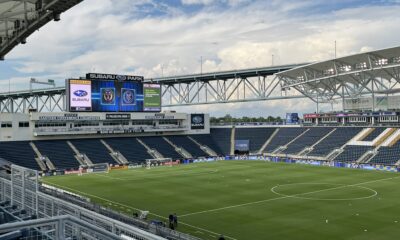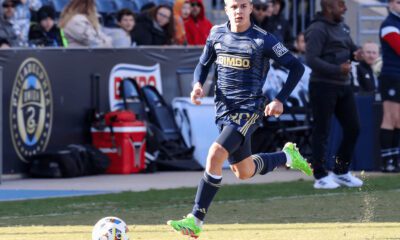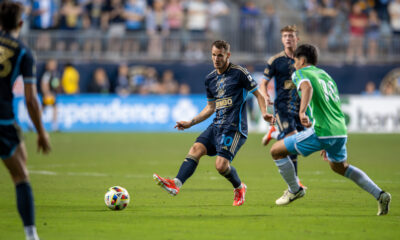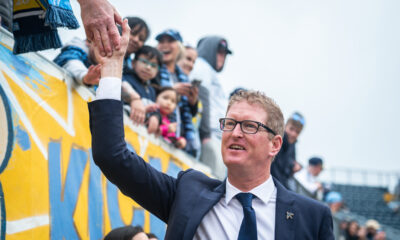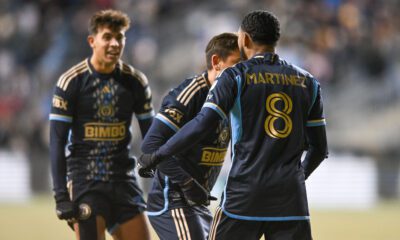Brotherly Game Archive
A Philadelphia Union perspective on a busy year ahead for the USMNT
What current and recently transferred Philadelphia Union players might we expect to see represent the U.S. in a busy year of competitions?
Earlier this week, USMNT head coach Greg Berhalter discussed the packed 2021 slate for his national team on Sirius XM with Glenn Crooks.
If everything goes according to plan, the USA will compete in the Concacaf Nations League knockouts, the Gold Cup, an Olympic campaign with U-23s, and the highly anticipated World Cup qualifiers.
Berhalter acknowledged that because of the heavy fixture list, he likely will have to “call on 30 to 40 players next year.” The United States’ depth and growth from the lows of 2018 will be extremely tested ahead of the looming 2022 World Cup.
During the December friendlies, I focused on how many pieces of the different squads Berhalter called would end up playing together in a final iteration of this cycle, ideally at Qatar. I certainly hope we get something close to an ideal team for the World Cup qualifiers, but nevertheless, this year’s congested schedule provides the opportunity to cycle through many different looks and players in competitive environments.
There will be plenty of time for full-blown selection discussions, but for now, let’s think about 2021 from a Union perspective. Which players can we expect to factor in Berhalter’s plans this season, and in what context? And yes, we’re going to include recent departures Brenden Aaronson and Mark McKenzie, because potentially having stars on the international stage who got their start in Philadelphia will always mean something to the fanbase.
Alejandro Bedoya
Bedoya is 33 years old and has 66 caps with the national team, but has not been called up since 2017. And in January of 2020, he had some interesting comments about Berhalter’s style of play, to say the least. Essentially, he thought Berhalter’s approach was ‘naive’ in gearing the side toward possession football, and that while he hoped the new style of play would come to fruition, he wasn’t sure if progress had been made since 2017.
Woof. Can a 33-year old squarely on the wrong side of the aging curve of a decidedly young team work his way back into a squad he has criticized? Nobody can guess at the relationship between Berhalter and Bedoya, and the Union star has never shied away from speaking his mind. He had no problem calling out what he saw as complacency in the Union side after their playoff departure to a Bruce Arena-coached New England Revolution.
Let’s unpack that for a second. Bedoya had mild success with the national team under an idealistic manager who was a poor tactician in Jurgen Klinsmann. The team made a knockout stage in 2014 behind some scrappy football, but stalled out due to a lack of any cohesive identity in early 2017. Arena, an ultra-pragmatist, nearly righted the ship to get the team to Russia but a blunderous night at Trinidad and Tobago derailed the entire federation’s plans. A possession idealist who is also a good tactician in Berhalter took over, but he wanted to start from scratch with young players who embraced his vision. Meanwhile in 2020, after Bedoya played a utilitarian role on a tactically flexible team, the Union bowed out of the playoffs as the majority of the players flustered when their carefully crafted system took a counterpunch from Arena’s plague-ball.
Idealism versus pragmatism. Possession football versus, to be kind, opportunistic football. These are the central questions to the Berhalter era and a lens worth viewing this team in. I wrote this in November after the 0-0 draw to Wales:
Berhalter’s identity is crucial in my opinion because at the national team level, too many teams are cobbled together and expected to fit great talent into suboptimal organization. The United States, until proven otherwise, are on the other end of the spectrum where the sum must be greater than the parts. That’s where Berhalter faces a conundrum, because his system banks on this team being better at possession football than their opponents. In a World Cup, it assuredly will not go like that. Is Berhalter justified in evolving the identity of his team when it won’t look that way at the level many fans want to see the USA succeed at? Can the USA have its cake and eat it too?
We know where Bedoya stands. I tend to agree with him if the goal is winning now, while recognizing that the entire federation and fanbase should let the team experience growing pains so that eventually the USA can play better football.
In a long winded way, whether or not Bedoya plays this year will come down to what statement Berhalter wants to make about how he wants to play. I can tell you the short list of people who I want starting at right midfield on the road in Central America in a World Cup qualifier, but only Berhalter can decide if counting on a workhorse 33-year old shuttler is worth the message it sends about American football.
And, maybe not everything has to exist in opposition to each other. Bedoya could anchor a fun side in the right spot of a midfield trio with the right team constructed around him. Change ‘trio to ‘diamond’ and you have the 2020 Philadelphia Union. The difference is building around Aaronson, Martinez, and Monteiro versus Christian Pulisic, Weston McKennie, and Tyler Adams.
Brenden Aaronson
The 20-year old starlet is off to RB Salzburg to learn from compatriot Jesse Marsch. I anticipate their match will boost Aaronson’s special trajectory as a transition wizard and adept presser. What I still don’t know is whether Aaronson will develop the skills needed to fully flourish as a No. 10, namely getting on the ball more in ways that unsettle entrenched defenses. Should he transition to a wing role and really hone in on the skills he is already elite at?
His path over the next few years should determine how exactly he fits into the national picture, but in either role he should find a home. He was devastating as a transition No. 10 in the 6-0 win over El Salvador, and in a first-choice squad, that would be his likely role if Pulisic, Jordan Morris, McKennie and Adams were all on the field. It’s just that he probably isn’t the third midfielder at this point with Yunus Musah continuing to impress with whole-field coverage and Sebastian Lletget offering more attacking oomph.
Aaronson could be a backup at the Gold Cup or the Nations League and see some spot minutes. And if he really is in great form he could crack a World Cup qualifier squad. However, I think at 20, he has a great opportunity in the Olympic qualifiers to fit in with a really exciting crop of players in an extremely tough group featuring Mexico, Costa Rica and the Dominican Republic. If he and the team play well there, the stage of the Olympics awaits in the summer in Tokyo. He’d have to be one of unquestioned stars on the U-23 team to take that route into minutes on the road to Qatar, but it’s a viable path.
It might be too much, too soon, for Aaronson to be a difference maker at the highest level in international football in 2021, but I believe we’ll get plenty of data on him in a USA uniform, and that should excite fans going forward.
Mark McKenzie
I really don’t want to compare the talent of McKenzie and Aaronson because both are stars in the making, and Union fans saw that firsthand this past season. That being said, I think Aaronson receives slightly more attention because he plays an attractive position and has some jawbreaking moments of brilliance. McKenzie, however, is probably closer to doing everything an elite center back should do, especially in a possession-based system. I think he could step into the national team this second next to John Brooks and it would work.
Of course, Berhalter probably isn’t going to do that. But the list of names I’d definitely rather see is a short one. Walker Zimmerman is great, and if Chris Richards is at Bayern, he might be great too. But Tim Ream, Matt Miazga, and Aaron Long? I think McKenzie can overtake them. The biggest thing for the new Genk signee is to play regularly and if he continues to rarely put a foot wrong, the sky remains the limit.
Like Aaronson, his most likely minutes will come through the Olympic matches with the U-23 cohort this year, and he should use it as a chance to cement himself as a leader in the back. I think he could easily be the third or fourth choice center back in any other competition, so it will be a matter of his availability with Genk and balancing his workload.
Out of all of the players in this list, I think McKenzie is most likely to feature on a field in a World Cup match. I’m that optimistic and I could be wrong, but I think the whole country should eagerly be following his progress in Belgium.
Matt Freese
Freese earned a shutout on Decision Day to help the Union secure the Supporters Shield to cap off a season with five backup appearances to 2020 MLS Goalkeeper of the Year Andrew Blake. Freese is a successful byproduct of the many pipelines to the MLS, coming through the Union Academy as a homegrown player, playing for Bethlehem Steel, Harvard and then back to the Union.
He has two caps with the U-23 team and should feature in the Olympic squad this year. He is currently in the January camp (unlike Aaronson and McKenzie) as one of three goalkeepers alongside JT Marcinowski (San Jose) and Brady Scott (Austin).
I can’t honestly project who out of those keepers will receive the lion’s share of the minutes but Marcinowski played 990 minutes this past season for the Quakes compared to Freese’s 437, while Scott was loaned out from Nashville in September to Sacramento before being selected in the Expansion Draft.
If Freese plays well, he could move his way into a solid circle on a strong depth chart that in my estimation of a rough order at the top, looks like Zack Steffen, Matt Turner, Brad Guzan (I’ll believe he’s done when he’s not in net at the Azteca), Bill Hamid, Ethan Horvath, and Sean Johnson. And behind them there’s a group that Freese could slide into featuring Tyler Miller, Stefan Frei, Jesse Gonzalez and David Ochoa (who is also a candidate for Olympic minutes). Miller in particular, is a good path for Freese to follow, having played at Northwestern, Seattle, LAFC (following an expansion draft) and Minnesota.
Matt Real and Anthony Fontana
The two 21-year-old Union homegrowns aren’t on any senior depth charts to be found, but both have caps with the U-20 team and are promising players going forward. They might be a step away from cracking a U-23 roster, especially this year, but could play their way into a conversation with a strong MLS campaign in 2021.
The good news for both is that the opportunity should be there with the departure of Aaronson at the 10 and the rumored exit of Kai Wagner at left back. Real is a great attacking fullback and luckily for him, the USA is notoriously bad there. Sam Vines is headlining MLS’s website as a potential international starter and not to knock him, but Real is about five good performances away from getting that recognition.
Fontana should deserve some hype already as a lethal player in the final third, who scored six goals in just over 500 minutes this year. I think his skillset is quite similar to Lletget, a player mentioned above who just makes things happen around goal. There is plenty for his game to grow, but he clearly can already turn an MLS game on his head, and I choose to see his limited sample size as a testament to how good Aaronson was. I don’t think Fontana is going to score a goal per 90 minutes in a full MLS campaign, but if he does even a third of that with some playmaking, he’ll generate national team buzz.

